|
|

Product Numbers: CHAS-7513-DC=, CHAS-7513-AC=, MAS-7513= (Cisco 7513)
CHAS-7576-DC=, CHAS-7576-AC=, MAS-7576=, and UPG-7513/7576= (Cisco 7576)
Customer Order Number: DOC-781897=
This publication provides instructions for replacing a Cisco 7513 or Cisco 7576 chassis, which is available as a spare part. It also includes instructions on upgrading a Cisco 7513 to a Cisco 7576.
The chassis is available as a spare part and as a kit to upgrade a Cisco 7513 to a Cisco 7576. The chassis includes all of the components required for operation except the processor modules and power supplies (MAS-7513=), (MAS-7576=), as a spare with power supplies (CHAS-7513-DC=, CHAS-7576-DC=, CHAS-7513-AC=, CHAS-7576-AC=), and as a kit to upgrade the Cisco 7513 to a Cisco 7576 (UPG-7513/7576=). After you replace the chassis, you must move the processor modules from your old chassis into your new chassis.
This publication contains the following sections:
The Cisco 7513 is a 13-slot router that supports multiprotocol, multimedia routing and bridging with a wide variety of protocols and any combination of available electrical interfaces and media. Network interfaces reside on interface processors that provide a direct connection between two CyBuses in the Cisco 7513 and your external networks. The Cisco 7513 has 13 slots: interface processor slots 0 through 5, Route Switch Processor (RSP) slots 6 and 7, and interface processor slots 8 through 12.
There are bays for up to two AC-input or DC-input power supplies. The chassis will operate with one power supply. While a second power supply is not required, it allows load sharing and increased system availability. The Cisco 7513 is shown in Figure 1. The three front-panel LEDs indicate system and power supply status, and LEDs on the RSP, interface processors, and power supplies indicate status.
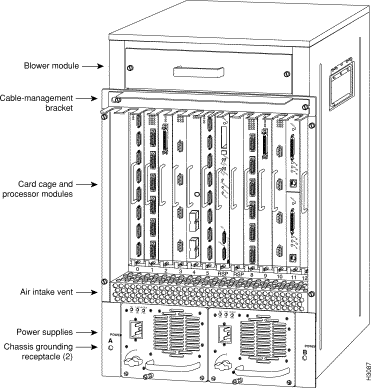
The Cisco 7576 is an independent dual router system that supports multiprotocol, multimedia routing and bridging with a wide variety of protocols and any combination of available electrical interfaces and media. The Cisco 7576 consists of two independent routers on a single split backplane within the chassis footprint of a Cisco 7513 router.
Network interfaces reside on interface processors that provide a direct connection between two independent dual CyBuses in the Cisco 7576 and your external networks. The backplane of the
Cisco 7576 has 13 slots and provides two routers on a single split backplane, designated router A and router B. Router A uses interface processor slots 0 through 5 and a Route Switch Processor (RSP4) in slot 6. Router B uses interface processor slots 8 through 12 and a Route Switch Processor (RSP4) in slot 7.
The Cisco 7576 (see Figure 2) is similar in most respects to the Cisco 7513. The differences between the two models are found in the backplane and the interface processor slot numbering scheme (see Figure 3) on the card cage.
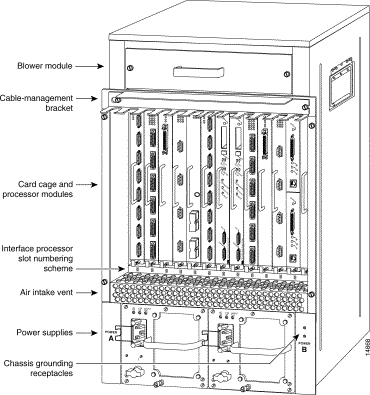

You can upgrade a Cisco 7513 to a Cisco 7576 with the Cisco 7576 Upgrade Kit (UPG-7513/7576=). The Cisco 7576 is similar to the Cisco 7513 except for the backplane and the interface processor slot numbering scheme located on the card cage. The upgrade kit does not include power supplies, RSPs, or interface processors. These all need to be transferred from your existing Cisco 7513 to the
Cisco 7576.
The Cisco 7576 Upgrade Kit includes:
To upgrade your Cisco 7513 to a Cisco 7576, follow these steps:
Step 1 Refer to the Cisco 7513 and Cisco 7576 Unpacking Instructions to unpack the unit.
Step 2 Refer to the Cisco 7513 and Cisco 7576 Chassis Replacement and Upgrade Instructions to upgrade the chassis.
Step 3 Determine whether your existing Cisco 7513 uses an AC-input or DC-input power supply.
Step 4 Refer to the 1200-Watt AC-Input Power Supply Replacement Instructions or the 1200-Watt DC-Input Power Supply Replacement Instructions (depending on what type of power supply is installed in your existing Cisco 7513), to transfer the power supplies from the Cisco 7513 to the Cisco 7576.
Step 5 Reinstall RSPs and interface processors.
 | Caution If you are only configuring one of the two routers that make up the Cisco 7576, make sure to configure router A instead of router B. To configure router A, install an RSP in slot 6 and install interface processors only in slots 0 through 5. |
Step 6 Refer to the Cisco 7500 Series Installation and Configuration Guide to perform installation, configuration, and troubleshooting on your new Cisco 7576 router.
Before you begin this installation, review the safety guidelines in this section to avoid injuring yourself or damaging the equipment. This section also provides a list of the tools that you need to perform the chassis replacement or upgrade.
Safety warnings appear throughout this publication in procedures that, if performed incorrectly, may harm you. A warning symbol precedes each warning statement.
| Warning This warning symbol means danger. You are in a situation that could cause bodily injury. Before you work on any equipment, be aware of the hazards involved with electrical circuitry and be familiar with standard practices for preventing accidents. To see translations of the warnings that appear in this publication, refer to the Regulatory Compliance and Safety Information document that accompanied this device. |
Waarschuwing Dit waarschuwingssymbool betekent gevaar. U verkeert in een situatie die lichamelijk letsel kan veroorzaken. Voordat u aan enige apparatuur gaat werken, dient u zich bewust te zijn van de bij elektrische schakelingen betrokken risico's en dient u op de hoogte te zijn van standaard maatregelen om ongelukken te voorkomen. Voor vertalingen van de waarschuwingen die in deze publicatie verschijnen, kunt u het document Regulatory Compliance and Safety Information (Informatie over naleving van veiligheids- en andere voorschriften) raadplegen dat bij dit toestel is ingesloten.
Varoitus Tämä varoitusmerkki merkitsee vaaraa. Olet tilanteessa, joka voi johtaa ruumiinvammaan. Ennen kuin työskentelet minkään laitteiston parissa, ota selvää sähkökytkentöihin liittyvistä vaaroista ja tavanomaisista onnettomuuksien ehkäisykeinoista. Tässä julkaisussa esiintyvien varoitusten käännökset löydät laitteen mukana olevasta Regulatory Compliance and Safety Information -kirjasesta (määräysten noudattaminen ja tietoa turvallisuudesta).
Attention Ce symbole d'avertissement indique un danger. Vous vous trouvez dans une situation pouvant causer des blessures ou des dommages corporels. Avant de travailler sur un équipement, soyez conscient des dangers posés par les circuits électriques et familiarisez-vous avec les procédures couramment utilisées pour éviter les accidents. Pour prendre connaissance des traductions d'avertissements figurant dans cette publication, consultez le document Regulatory Compliance and Safety Information (Conformité aux règlements et consignes de sécurité) qui accompagne cet appareil.
Warnung Dieses Warnsymbol bedeutet Gefahr. Sie befinden sich in einer Situation, die zu einer Körperverletzung führen könnte. Bevor Sie mit der Arbeit an irgendeinem Gerät beginnen, seien Sie sich der mit elektrischen Stromkreisen verbundenen Gefahren und der Standardpraktiken zur Vermeidung von Unfällen bewußt. Übersetzungen der in dieser Veröffentlichung enthaltenen Warnhinweise finden Sie im Dokument Regulatory Compliance and Safety Information (Informationen zu behördlichen Vorschriften und Sicherheit), das zusammen mit diesem Gerät geliefert wurde.
Avvertenza Questo simbolo di avvertenza indica un pericolo. La situazione potrebbe causare infortuni alle persone. Prima di lavorare su qualsiasi apparecchiatura, occorre conoscere i pericoli relativi ai circuiti elettrici ed essere al corrente delle pratiche standard per la prevenzione di incidenti. La traduzione delle avvertenze riportate in questa pubblicazione si trova nel documento Regulatory Compliance and Safety Information (Conformità alle norme e informazioni sulla sicurezza) che accompagna questo dispositivo.
Advarsel Dette varselsymbolet betyr fare. Du befinner deg i en situasjon som kan føre til personskade. Før du utfører arbeid på utstyr, må du vare oppmerksom på de faremomentene som elektriske kretser innebærer, samt gjøre deg kjent med vanlig praksis når det gjelder å unngå ulykker. Hvis du vil se oversettelser av de advarslene som finnes i denne publikasjonen, kan du se i dokumentet Regulatory Compliance and Safety Information (Overholdelse av forskrifter og sikkerhetsinformasjon) som ble levert med denne enheten.
Aviso Este símbolo de aviso indica perigo. Encontra-se numa situação que lhe poderá causar danos físicos. Antes de começar a trabalhar com qualquer equipamento, familiarize-se com os perigos relacionados com circuitos eléctricos, e com quaisquer práticas comuns que possam prevenir possíveis acidentes. Para ver as traduções dos avisos que constam desta publicação, consulte o documento Regulatory Compliance and Safety Information (Informação de Segurança e Disposições Reguladoras) que acompanha este dispositivo.
¡Advertencia! Este símbolo de aviso significa peligro. Existe riesgo para su integridad física. Antes de manipular cualquier equipo, considerar los riesgos que entraña la corriente eléctrica y familiarizarse con los procedimientos estándar de prevención de accidentes. Para ver una traducción de las advertencias que aparecen en esta publicación, consultar el documento titulado Regulatory Compliance and Safety Information (Información sobre seguridad y conformidad con las disposiciones reglamentarias) que se acompaña con este dispositivo.
Varning! Denna varningssymbol signalerar fara. Du befinner dig i en situation som kan leda till personskada. Innan du utför arbete på någon utrustning måste du vara medveten om farorna med elkretsar och känna till vanligt förfarande för att förebygga skador. Se förklaringar av de varningar som förkommer i denna publikation i dokumentet Regulatory Compliance and Safety Information (Efterrättelse av föreskrifter och säkerhetsinformation), vilket medföljer denna anordning.
The following guidelines will help to ensure your safety and protect the equipment. These guidelines are not inclusive of all potentially hazardous situations, so be alert.
The following are general precautions for any workplace:
Follow these guidelines when working with any electrical equipment:
In addition, use the guidelines that follow when working with any equipment that is connected to telephone wiring or other network cabling:
A fully configured chassis weighs approximately 160 pounds (72.6 kilograms [kg]). Before installing the new (replacement) chassis, ensure that your site is properly prepared, so you can avoid having to move the chassis later to accommodate power sources and network connections.
Electrostatic discharge (ESD) damage, which can occur when electronic boards or components are handled improperly, can result in complete or intermittent failures. Each processor module consists of a printed circuit board that is fixed in a metal carrier. EMI shielding, connectors, and a handle are integral components of the carrier. Handle processor modules by the metal frame or carrier only; avoid touching the board (particularly avoid touching any components, connector pins, or the metal fingers on the edge connector).
Following are guidelines for preventing ESD damage:
 | Caution For safety, periodically check the resistance value of the antistatic strap. The measurement should be between 1 and 10 megohms. |
If possible, position the new replacement chassis close enough to the existing system so that you can avoid having to disconnect power and interface cables. Be sure to disengage any strain relief devices before attempting to pull the cables from the port. Following are descriptions of the different methods of strain relief that are used on the AC-input and DC-input power cables and the various types of network interface cables:
When removing any cable, pull the cable out at the connector; never pull or tug on the cable itself. For detailed descriptions of the system components, refer to the Cisco 7500 Series Installation and Configuration Guide.
Although some network downtime is unavoidable while you remove the RSPs from the old chassis, and replace them in the new chassis, you can minimize the downtime by placing the old and new chassis close together. If your existing chassis is mounted in a rack and there is space in the same rack or another rack close by, we recommend that you install the new, empty chassis in the rack before moving the components. (A fully configured chassis weighs approximately 160 pounds.)
Before installing the chassis in a new rack location, ensure that routing the interface cables to the new positions will not strain or tangle them.
You can further minimize downtime by leaving interface cables attached when you move interface processors to the new chassis, provided that doing so will not strain the cables.
Leave network interface cables connected to the interface ports only if the following conditions are true:
Ensure that your new chassis allows sufficient clearance for maintenance—to remove and replace processor modules, the blower module, and interface cables at the interface processor end, and to access the internal components at the noninterface processor end.
Figure 4 shows the chassis footprint and the clearance required.
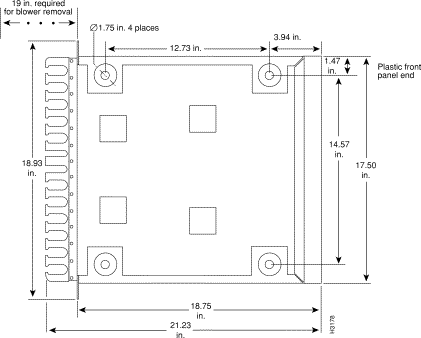
This section lists the tools and parts you will need to complete these replacement procedures. Have the necessary tools on hand so that you can complete the replacement without interruption:
The RSP is a required system component and should only be removed when the system is not operating, although power can be on to the chassis. All interface processors support online insertion and removal (OIR); however, after installing an interface processor, you must wait at least 15 seconds for the system to reinitialize the interfaces before installing the next interface processor. Therefore, it is more efficient to leave the power off until all components are moved into the new chassis, then start up the system and check the entire installation.
If you are installing the new chassis in an equipment rack, proceed to the next section. Otherwise, proceed to the "Moving Processor Modules from the Old Chassis to the New Chassis" section.
This section describes how to replace a chassis that is installed in an equipment rack. The order in which you remove the existing system, install the new chassis, and replace the components will vary depending upon the space available in the rack and in the work area.
Some rack configurations, such as an enclosed rack or a rack with a power strip that limits access, prohibit the normal installation sequence of first installing the chassis in the rack and then installing the cable-management brackets before installing the processor modules. In these situations, you can move all the components into the new chassis before installing it in the rack, but ensure that you follow the safety guidelines for lifting and working with electrical equipment that are provided in the section "Safety Guidelines" beginning on page 8.
If there is sufficient space available in the same rack (or an adjacent rack) and you have a rack-mount kit available, you can install the new (replacement) chassis before you remove the existing system. You can minimize downtime and avoid having to disconnect network interface cables by leaving the existing system operating while you install the empty replacement chassis in the rack. Also, an empty chassis is significantly lighter and easier to handle than one that is fully configured. Just ensure that both chassis, when installed, will be close enough to avoid straining the interface cables connected to the interface processors.
If you must remove the existing system to make room for the replacement chassis, or if you need the existing rack-mounting hardware to mount the new chassis, you will have to disconnect all network interface cables before removing the existing system from the rack. You can leave the system components in the old chassis until after you install the new, empty chassis in the rack.
Assess your rack and lab configuration and the equipment you have available, and then choose the appropriate replacement procedure from the following:
Before removing the existing chassis from the rack, you must shut down the system power and disconnect the power cable and all interface cables. To help avoid problems when you install the new chassis, label all interface cables with their slot/port address and mark the positions of the chassis ears (with tape, chalk, or a marker) so that you can install the new chassis in the same position.
Two chassis ears hold the chassis in the rack (see Figure 5), but do not bear the weight of the chassis. The ears are secured to the chassis sides and to the rack posts. The chassis is supported by the two rack brackets.
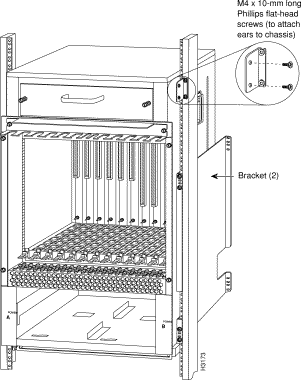
We recommend that two people perform this procedure: one person should support the chassis while the other person removes the screws that secure the ears to the rack.
To remove the existing chassis from the rack, follow these steps:
Step 1 Turn off the system power and disconnect the power cable and all interface cables from the chassis.
Step 2 Use a screwdriver to loosen and remove each of the four screws (two on each side) that secure the chassis ears to the rack rails.
Step 3 Pull the chassis out of the rack and place it on the floor or a table.
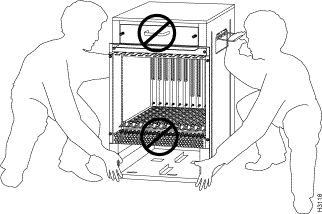
This completes the chassis removal procedure.
If you have not yet installed the new chassis in the rack, proceed to the next section.
Mount the chassis in the rack before connecting any interface or power cables. If possible, install the new, empty chassis in the rack first, and then install the system components from the old chassis. To mount the chassis, install the ears on the chassis first, place the chassis in the rack, and then secure the ears to the rack rails.
We recommend that two people perform this procedure. Before lifting the chassis, ensure that your path to the rack is unobstructed.
To install the chassis in the rack, follow these steps:
Step 1 Two people are required to perform this step. With a person positioned at either side of the chassis, grasp the bottom edge of the chassis with one hand near the front and the handle on the side of the chassis with the other, as shown in Figure 6.
Step 2 Grasping the chassis as shown in Figure 6, slowly lift the chassis in unison. To prevent injury, avoid sudden twists or moves.
Step 3 With the chassis positioned so the front is closest to the rack, insert the front of the chassis into the rack between the brackets, and then slowly lower the chassis until it rests on the two bracket ledges. (See Figure 7.)

Step 4 Slide the chassis back into the rack along the ledges until the ears meet the front mounting posts on both sides of the rack. (See Figure 7.)
Step 5 Secure each ear to the rack-mounting post with two 10-32 x 5/8-inch, phillips pan-head screws.
This completes the procedure for moving the chassis into the rack.
The cable-management bracket attaches to the interface processor end of the chassis just above the card cage and below the blower module. (See Figure 8.) Use the bracket to keep network interface cables untangled and orderly, and to prevent cables from hindering access to interface processors in the interface processor slots.
Install the bracket before connecting network interface cables to the interface processor ports; otherwise, you will probably need to disconnect the cables to install the screws that secure the brackets. Route interface cables through the bracket as you connect them to the interface processor ports.
You will need the following tools and parts to install the cable-management brackets; brackets and pan head screws are included with the chassis:
To install the cable-management bracket on the router, follow these steps:
Step 1 On the interface processor end of the chassis, locate the two slotted screws positioned below the blower module and above the card cage. (See Figure 8.)
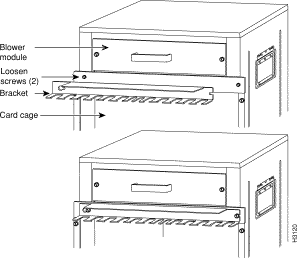
Step 2 Use a flat-blade screwdriver to loosen the two slotted screws approximately 1/8-inch.
Step 3 Place the bracket over the screws (see Figure 8), and slide the bracket to the right.
Step 4 Use a flat-blade screwdriver to tighten the screws.
Step 5 When installing the network interface cables, route the cables up to and through the cable-management bracket.
Route the excess cable out through either end of the bracket, coil it, and secure it to the rack using nylon cable ties, or some other mode of attachment.
It might be necessary to bundle longer cables to avoid tangling them. Do this at the cable-management bracket or at the rack, but leave enough slack in the cables to remove processor modules. Change cables as required. Also, do not block the power supply air vents with cables.
This completes the procedure for installing the cable-management bracket.
At the interface processor end of the chassis, slots contain the processor modules. (See Figure 1.) In the Cisco 7513, the RSP occupies RSP slot 6 or 7. In the Cisco 7576, the RSP placed in slot 6 controls router A and the RSP in slot 7 controls router B. The remaining 11 slots support any combination of interface processors.
Processor modules are keyed with guides on the backplane to prevent them from being fully inserted in the wrong slot. Empty interface processor slots contain an interface processor filler (an empty carrier) to help keep dust out of the chassis, provide electromagnetic interference (EMI) shielding, and maintain proper air flow through the chassis interior.
Processor modules slide into the processor slots and connect directly to the backplane. The spring-loaded ejector levers (see Figure 9) help to ensure that the bus connector on the back of the processor module is fully seated in the backplane or fully dislodged from it. Captive installation screws at both ends of each processor module faceplate prevent the processor from pulling away from the backplane and support the EMI integrity of the system. Failure to use the ejector levers and captive installation screws could result in a partial backplane connection, which can hang the system.
If you are replacing a Cisco 7513 chassis, move the interface processors to the same slot positions in the new chassis to retain your existing configuration. When upgrading a Cisco 7513 to a Cisco 7576, it is not possible to retain the existing configuration. The lithium battery backup on the RSP retains the system configuration in nonvolatile random-access memory (NVRAM). Therefore, if you install interface processors in the same slot positions in the new chassis that they occupied in the old chassis, the system and the individual interfaces should come up in their previous configuration. If you install interface processors in different slots in the new chassis, the system will recognize the interfaces, but will leave them in a shutdown state until you reconfigure and enable them.
Although interface processors support OIR, you must wait at least 15 seconds after inserting an interface processor before inserting the next one. To help avoid errors with the installation, leave the power off until you have moved all components into the new chassis and have verified that all of them are installed properly.
Move the interface processors first, one at a time, then move the RSPs last. Before you remove an interface processor from the existing chassis, remove the interface processor filler from the corresponding slot in the new chassis. Then immediately install the interface processor in the new chassis and secure it in the slot before removing the next interface processor filler or module. If you leave the interface cables attached to the interface processors, route the cables through the cable-management brackets immediately after you secure the interface processor in the slot to help keep the other slots clear during the installation.
If there is sufficient slack in the interface cables, and if you can easily move the processor modules between the chassis without straining the cables, leave the interface cables connected. If you must disconnect the cables, label each cable with its slot and port number before you disconnect it. Do not reconnect the interface cables until you have installed all of the components in the new chassis (it is easier to install interface processors when the slots are not impeded by cables that drop from other slots). Use the optional cable-management brackets to keep the interface cables untangled and away from other interface processor slots and ports.
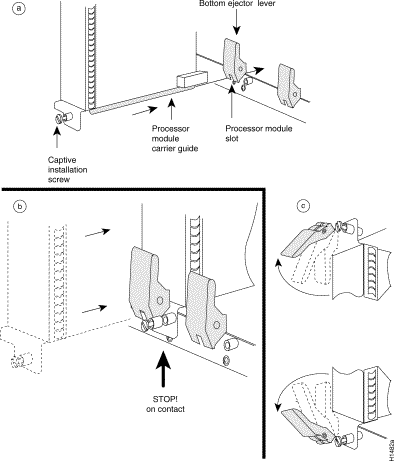
To move the processor modules to the new chassis, follow these steps:
Step 1 Before moving any processor modules, ensure that you have met the following prerequisites (refer to the "What is the Cisco 7513?" section" or the "What is the Cisco 7576?" section for details):
Step 2 Note the slot location of the interface processor you are going to move. Before removing the interface processor, remove the interface processor filler from the corresponding slot in the new chassis. When installing interface processors in the new chassis, place them in the same slot position that they occupied in the old chassis; this will retain your existing configuration and will help avoid confusion when reconnecting cables and checking the installation.
Step 3 If necessary, disconnect any interface cables that are connected to the processor module.
Step 4 Use a screwdriver to loosen both captive installation screws on the processor module. (See Figure 9a.)
Step 5 Place your thumbs on the end of each ejector and simultaneously pull both ejectors outward, away from the carrier handle (in the opposite direction from that shown in Figure 9c) to release the processor module from the backplane.
 | Caution You must install the RSP in one of the slots labeled RSP (slot 6 or 7). We recommend that you place the RSP in the same slot in the new chassis that it occupied in the old one. You can install interface processors in any of the interface processor slots (the lowest slots), but we recommend that you install them in the same slot positions that they occupied in the old chassis. The slots are keyed for correct installation. Forcing a processor module into the wrong slot can damage the backplane and board connectors. |
Step 6 Grasp the processor module handle with one hand and pull the processor module straight out of the slot, keeping your other hand under the carrier to guide it. (See Figure 10.) Keep the carrier at a 90-degree orientation to the backplane. Avoid touching the board or any connector pins.
Step 7 Place the processor module in the same slot position in the new chassis and align the notches along the edge of the carrier with the grooves in the slot. (See Figure 9a.)
Step 8 While keeping the carrier at a 90-degree orientation to the backplane, carefully slide the carrier into the slot until the back of the faceplate makes contact with the ejector levers, and then stop. (See Figure 9b.)
Do not use unnecessary force when installing processor modules. Always guide the carrier into the slot only until the carrier faceplate makes contact with the ejector levers; then use the ejector levers to complete the insertion.
Step 9 Using the thumb and forefinger of each hand to pinch each ejector, simultaneously push both ejectors inward (toward the carrier handle) until they snap into place and are at a full 90-degree orientation to the faceplate. (See Figure 9c.) The carrier ears (the ends of the faceplate) should be flush against the chassis.
Step 10 Use a screwdriver to tighten the two captive screws to prevent the processor module from becoming partially dislodged from the backplane and to ensure proper EMI shielding.
Step 11 Repeat Steps 2 through 10 for the remaining interface processors.
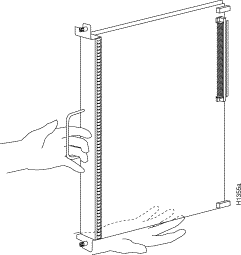
This completes the processor module removal and replacement procedure. If you need to install the new chassis in an equipment rack, proceed to the "Installing the New Chassis in the Rack" section. Otherwise, proceed to the next section to check the installation.
To complete the replacement procedure, perform the following steps to verify that the system is functioning properly. These steps will also help you verify that all the processor modules you moved are returned to their previous state. For additional first-time startup troubleshooting procedures, refer to the Cisco 7500 Series Installation and Configuration Guide.
Because the lithium battery backup on the RSP retains the system configuration in NVRAM, the system and the individual interfaces should come up in their previous configuration, provided that you installed the interface processors in the same slots they occupied in the old chassis.
If, however, you installed interface processors in different slot positions in the new chassis, the system will recognize the interfaces, but will leave them in a down state until you reconfigure and enable them.
If you need technical assistance, refer to the "Cisco Connection Online" section.
Step 1 Ensure that the system power switch is off, and then reconnect the power cable to the AC receptacle or DC terminal block, as required. For the AC-input power supply, snap the cable retention clip up around the plug to secure the cable. For the DC-input power supply, reattach a new nylon cable tie to support the weight of the cable.
Step 2 Connect all interface cables to the appropriate interface processor ports. Ensure that all cables are fully seated in the ports and that all strain relief systems are engaged.
Step 3 Ensure that you have either a console terminal connected to the system console port or a port available for a Telnet session to the router.
Step 4 Turn on the system power. On the power supplies, the (AC or DC) OK LED should go on and stay on. (See Figure 11.)
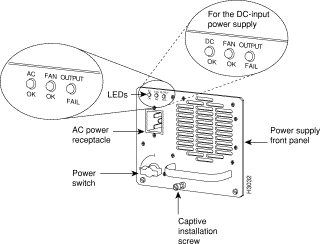
If the system does not go on, check the following: If the system goes on, go to step 5.
Step 5 Verify that the normal LED on the RSP goes on and stays on. This indicates if the system software booted successfully. If the LED goes on, proceed to step 6. If it does not go on, do the following:
Step 6 When the system boot is complete, the RSP begins to initialize the interface processors. During initialization, the LEDs on each interface processor behave differently (most flash on and off). The enabled LED on each interface processor goes on when initialization is completed.
Step 7 If the enabled LED on a single interface processor remains off, suspect that the interface processor has shifted out of its slot. Use the ejector levers to release the interface processor and reseat it in the backplane. (Refer to the "Moving Processor Modules from the Old Chassis to the New Chassis" section for removal and insertion steps.) Tighten both captive installation screws, and then return to Step 1.
Step 8 If an enabled LED still fails to go on after performing these steps, suspect that the specific interface processor has failed. Contact a service representative.
Step 9 Verify that the console terminal displays a script and system banner similar to the following:
GS Software (RSP-K), Version 10.3(571), SOFTWARE
Copyright (c) 1986-1995 by cisco Systems, Inc.
Compiled Wed 10-May-95 14:46 by mpo
System Bootstrap, Version 4.6(1) [fc2], SOFTWARE
Step 10 After the system initializes, enter the various show commands to display the status of the system and individual interfaces, and ensure that they are operating according to their previous configuration. (For descriptions and examples of these commands, refer to the following section, "Verifying the Installation Using show Command Descriptions and Examples.")
When the system starts up and operates successfully, the replacement procedure is complete, and you can resume normal operation.
If the system still fails to start up or operate properly, or if you isolate the cause of the problem to a failed component, contact a service representative for further assistance.
This section describes the various show commands that you can use to display system status and configuration. If you installed the interface processors in the same slot locations that they occupied in the old chassis, the interfaces should retain the same configuration. If you installed the interface processors in different slot locations, the system will recognize the interfaces, but you will have to use the configure command to reconfigure and enable them.
You can check the version of the default ROM image either by removing the board and checking the ROM labels or by configuring the interface or system software to boot from ROM, restarting the system, and using these same commands to check the running version.
Enter the show version command to display the current system software version, and enter the show controllers cxbus command to display the microcode version of the RSP and each interface processor. The following is an example of the show version command.
Router> show version
GS Software (RSP-K), Version 10.3(571), SOFTWARE
Copyright (c) 1986-1995 by cisco Systems, Inc.
Compiled Wed 10-May-95 14:46 by mpo
System Bootstrap, Version 4.6(1) [fc2], SOFTWARE
Current date and time is Sat 1-22-1994 21:38:35
Boot date and time is Tue 12-28-1993 15:32:28
Router uptime is 3 weeks, 4 days, 6 hours, 7 minutes
System restarted by reload
System image file is "gs7-k.103-1", booted via tftp from 1.1.1.12
(example text omitted
X.25 software, Version 2.0, NET2 and BFE compliant.
Bridging software.
1 EIP controller (6 Ethernet).
1 TRIP controller (4 Token Ring).
6 Ethernet/IEEE 802.3 interfaces.
4 Token Ring/IEEE 802.5 interfaces.
(remainder of example text omitted)
Following is an example of the show controller cbus command display. (In this example, ROM Version 1.0 is assumed because you cannot determine the ROM version with screen displays unless it is the running version.)
Router# show controllers cbus
(text omitted from example)
FSIP 1, hardware version 1.0, microcode version 1.0
Interface 8 - Serial1/0, electrical interface is V.35 DTE
(text omitted from example)
Interface 9 - Serial1/1, electrical interface is V.35 DTE
(remainder of displayed text omitted from example)
The command show interfaces serial slot/port displays statistics for the specific serial interface you specify by its slot/port address. If you enter this command without the type and slot/port arguments, the system will display statistics for all interfaces in the system.
Router> show int hssi 1/0
Hssi 1/0 is up, line protocol is up
Hardware is cxBus HIP
Internet address is 1.1.1.9, subnet mask is 255.255.255.0
(display text omitted)
The command show configuration displays the contents of the system configuration file stored in NVRAM.
Router# show config
Using 1652 out of 130048 bytes
version 10.3(571)
!
hostname Router
!
enable-password guessagain
!
microcode TRIP flash trip1-0
microcode reload
!
interface hssi1/0
ip address 1.1.1.67
ip route-cache cbus
no keepalive
!
interface serial2/1
ip address 1.1.1.12
(display text omitted)
The command show protocols displays the global (system-wide) and interface-specific status of any configured Level 3 protocol.
Router> show protocols
Global values:
Internet Protocol routing is enabled
Hssi1/0 is up, line protocol is up
(display text omitted)
The port and slot configuration worksheet (Table 1) is used in conjunction with Figure 12 to assist in planning and documenting your use of the slots in a Cisco 7513 or Cisco 7576 router. Figure 12 shows the dual CyBus backplane without the Time Division Multiplexing (TDM) connectors found on the Cisco 7576.
The dual CyBus backplane has 13 slots: interface processors are placed in slots 0 through 5 and slots 8 through 12. RSPs are placed in slots 6 and 7.
The Cisco 7576 consists of two independent routers on a single split backplane. These are designated router A and router B.
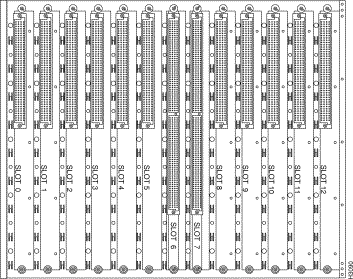
| Port | Slot 0 | Slot 1 | Slot 2 | Slot 3 | Slot 4 | Slot 51 | Slot 8 | Slot 9 | Slot 10 | Slot 11 | Slot 12 |
|---|---|---|---|---|---|---|---|---|---|---|---|
| 1 |
|
|
|
|
|
|
|
|
|
|
|
|
|
|
|
|
|
|
|
|
|
| |
| 2 |
|
|
|
|
|
|
|
|
|
|
|
|
|
|
|
|
|
|
|
|
|
| |
| 3 |
|
|
|
|
|
|
|
|
|
|
|
|
|
|
|
|
|
|
|
|
|
| |
| 4 |
|
|
|
|
|
|
|
|
|
|
|
|
|
|
|
|
|
|
|
|
|
| |
| 5 |
|
|
|
|
|
|
|
|
|
|
|
|
|
|
|
|
|
|
|
|
|
| |
| 6 |
|
|
|
|
|
|
|
|
|
|
|
|
|
|
|
|
|
|
|
|
|
| |
| 7 |
|
|
|
|
|
|
|
|
|
|
|
|
|
|
|
|
|
|
|
|
|
| |
| 8 |
|
|
|
|
|
|
|
|
|
|
|
|
|
|
|
|
|
|
|
|
|
| |
Router Name(s)
| Location | Serial Number | |||||||||
| 1Slots 6 and 7 are reserved for the RSPs in the Cisco 7513 and Cisco 7576. However, in the Cisco 7576, slot 6 is used for router A, and slot 7 is used for router B. |
Cisco Connection Online (CCO) is Cisco Systems' primary, real-time support channel. Maintenance customers and partners can self-register on CCO to obtain additional information and services.
Available 24 hours a day, 7 days a week, CCO provides a wealth of standard and value-added services to Cisco's customers and business partners. CCO services include product information, product documentation, software updates, release notes, technical tips, the Bug Navigator, configuration notes, brochures, descriptions of service offerings, and download access to public and authorized files.
CCO serves a wide variety of users through two interfaces that are updated and enhanced simultaneously: a character-based version and a multimedia version that resides on the World Wide Web (WWW). The character-based CCO supports Zmodem, Kermit, Xmodem, FTP, and Internet e-mail, and it is excellent for quick access to information over lower bandwidths. The WWW version of CCO provides richly formatted documents with photographs, figures, graphics, and video, as well as hyperlinks to related information.
You can access CCO in the following ways:
For a copy of CCO's Frequently Asked Questions (FAQ), contact cco-help@cisco.com. For additional information, contact cco-team@cisco.com.

![]()
![]()
![]()
![]()
![]()
![]()
![]()
![]()
Posted: Tue Oct 15 08:27:53 PDT 2002
All contents are Copyright © 1992--2002 Cisco Systems, Inc. All rights reserved.
Important Notices and Privacy Statement.